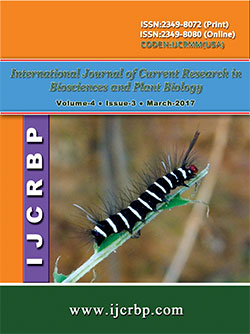 |
Online ISSN : 2349-8080 Issues : 12 per year Publisher : Excellent Publishers Email : editorinchiefijcrbp@gmail.com |
Monascus purpureus was used for pigment production in different media. Synthetic medium containing (gL-1 glucose, 30; MSG, 1.5; KH2PO4, 2.5; MgSO4.7H2O, 0.5 and FeSO4. 7H2O, 14 mg/l) yielded the maximum pigment production (3.6 AU/ml) followed by potato dextrose broth (3.4 AU/ml) and malt extract medium (2.8 AU/ml). The optimized synthetic medium showed 1.5 fold increases in the pigment production. Further, solid state fermentation was carried out using wheat, rice, jackfruit seed powder and cotton fibers in the form of 1-2 cm length flakes absorbed with potato dextrose broth. Maximum pigment production (65.0 AU/gds) was obtained in rice followed by wheat (62.0 AU/gds) followed by jackfruit seed powder (60.0 AU/gds) and cotton (58.0 AU/gds). Solid state fermentation was more effective than submerged fermentation for overall pigment production by M. purpureus. Pigment was found to be stable from pH 3.0 to 9.0 and temperature 37°C to 121°C. Along with the pigment, M. purpureus also produced citrinin which was analyzed using TLC. A process for the production of citrinin- free Monascus pigment has also been investigated which will be useful for various food applications. A correlation was established between citrinin antimicrobial activity and pigment production method. The pigment produced through solid- state and submerged fermentation showed inhibitory activity against Staphylococcus aureus, Shigella spp. and Bacillus spp. Hence, the pigment is useful as a food additive and to control the food- borne pathogens and to enhance the shelf- life of food products.
